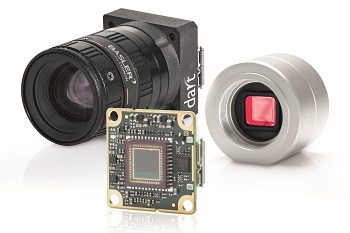Camera manufacturer Basler has expanded its dart and pulse camera series to include the EV76C570 sensor from e2V. The new camera models stand out for their outstanding image quality, thanks in no small part to a pixel size of 4.5 x 4.5 µm. The devices can achieve frame rates of up to 60 fps, and use global shutter technology to ensure focused images even for quick-moving objects. These new camera models will move into series production in November.

The EV76C570 sensor from e2V is notable for its 4.5 x 4.5 µm pixel size, delivering image quality at an impressive 2 MP of resolution. It offers a maximum image circle of 1/1.8 inch, and is the largest sensor in the dart as well as pulse camera series. This new addition makes the cameras an outstanding choice for use in industrial and biomedical microscopy, with the color fidelity, color reproduction and compatibility with real-time transmission required for those fields. The classic 4:3 format used here also ensures that the microscope's image circle optimally matches the sensor's.
Beyond this, the new models feature a global shutter sensor to allow for high speeds of up to 60 fps. When an ROI - Region of Interest - is set manually, this can be raised even further. These dart and pulse models thus offer optimal specifications for applications in factory automation and Intelligent Traffic Systems (ITS). With their diminutive footprint and high image transmission rates, they are also ideally suited for use in robotics.
The Basler dart board level camera brings together the latest USB 3.0 camera technology, a cost-optimized design and Basler's proven reliability and quality, all at an entry-level price of €99.
The Basler pulse is flexible and can be integrated into a broad range of applications in the fields of Medical & Life Sciences, ITS and Retail. It's especially well suited for use in microscopy applications. The pulse is notable for its robust metal housing and low power consumption.
Both cameras, the board level dart and the pulse, conform to the USB3 Vision standard.
For more information, please visit us at www.baslerwebc.com/dart and www.baslerweb.com/pulse.